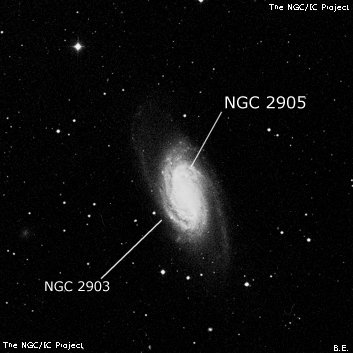
William Herschel discovered NGC 2905 = H I-57 = h604.II on 16 Nov 1784 (sweep 318) and recorded (together with NGC 2903) "cB, cL, a small bright spot in the middle; at first sight appears very much elongated, but by careful attention it appears to consist of two; the nf of which less bright than the sp, though nearly of the same size and shape with the former, it has also a brightish spot in the middle but not nearly so brilliant as the other; dist of the center about a minute."
On 25 Mar 1830 (sweep 244), John Herschel recorded, " NGC 2903] is vB; E; gbM; r[esolvable]. Long attentions shows a vF, L, R, neb attached n f." NGC 2905 is the "neb attached n[orth] f[ollowing]" and refers to a brighter starcloud of large HII region in the northeast spiral arm. George Stoney's sketch at Birr Castle on 5 Mar 1848 shows multiple spiral arms, along with a distinct embedded knot on the northeast side. RNGC classified this number as nonexistent (Type 7), although Type 35 = nebulous region in a galaxy, would probably be more appropriate.
300/350mm - 13.1" (12/22/84): very faint knot or arc at NE edge of arm of NGC 2903.
400/500mm - 17.5" (5/10/86): very large knot or arc at the NNE edge of a spiral arm in NGC 2903. Easily visible with averted vision.
600/800mm - 24" (2/22/14): just beyond the northeast end of the central bar is a fairly bright, irregular "knot" (NGC 2905) where the northern spiral arm attaches to the bar. This arm bends sharply to the west (clockwise), but only curves for ~1' and quickly fades.
900/1200mm - 48" (4/18/15): NGC 2905 is the brightest of several luminous patches along the central bar. This irregular knot is located very near the north-northeast end of the central bar at the point where two spiral arms (extending west) emerge from the arm.
Notes by Steve Gottlieb